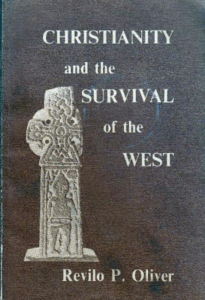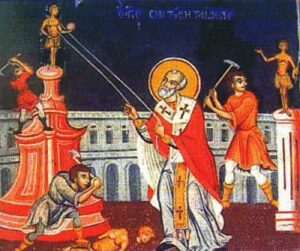and the survival of the West, 3
by Revilo Oliver (1973)
Chapter Three: CHRISTIANITY TODAY
 If you desire to preserve our country and our civilization, you must face two fundamental facts.
If you desire to preserve our country and our civilization, you must face two fundamental facts.
The first of these is that 90% of all the active support of pro-American efforts has come from Christians.
Of that, there can be no doubt. Almost without exception, all of the thousands of “conservative” and “anti-Communist” organizations that have come and gone during the past fifty years have been specifically Christian, proposing to defend Christianity and the Constitution simultaneously. Many of the most active organizations today are evangelical and try to revive Christian faith by holding meetings in which the Gospel and patriotism are inseparably blended. Some organizations specifically established to resist or promote certain legislation do not explicitly raise religious issues, but they take Christianity for granted. The only patriotic organizations that are explicitly non-Christian are a small periodical, The Truth Seeker, which, having spoken disrespectfully of Jews, is now being forced to the wall, and one small “activist” group in California.
It is true that a very successful promotion was founded by a master-salesman who began by admitting, with a show of candor, that he rejected belief in a personal god as childish and preferred a vague pantheism that recognized an “upward reach” in “all mankind” that was similar to the upward reach of growing plants. But after testing the market, he began to claim that he was purveying a doctrine that was a kind of pep pill good for all religions and guaranteed to make the purchaser a better Christian, better Pharisee, or better Moslem, as the case might be. (There are no Buddhists, Parsees, Yezidis, Jains, Saivites, or Tantrists with large bank rolls in the United States at the present time, nor are they represented by oil-rich governments abroad.) The only point that need concern us now is that the promoter accurately gauged his market. Of all the members who passed through his organization in its heyday, at least 80% were Christians—probably 90% of those who really worked and gave money to the limit of their resources.
You have only to attend any “anti-Communist” meeting, including both the most sincere efforts and the most fraudulent promotions, and talk to the persons who attend and contribute to convince yourself that almost all of them are Christians, and by that I mean persons who really believe in Christ, as distinct, of course, from the many persons who attend Sunday-morning clubs because they think it good for business, politically expedient, or socially amusing. Whether you like it or not, you must accept the fact that 90% of the active support for patriotic and pseudo-patriotic efforts comes from men and women who have a sincere faith in Christ.
During more than two decades, the active Defense of the West has rested almost entirely on the shoulders of Christians in all Occidental nations. And that has been true on all levels. I know that comparisons are invidious, but to make my point I will say that if I had to pick one periodical on our side as having the highest literary finish and intellectual content, I should have to name Découvertes, the monthly publication of a highly cultivated group of staunchly Christian Frenchmen now in Lisbon.
That is not astonishing. For almost fifteen centuries Occidental civilization was Christendom, and, as is shown by the data that we have always examined, Christianity as we know it is, and always has been, an Indo-European religion, incomprehensible to the rudimentary minds of the primitive races and unacceptable to the subtle minds of the Orientals who have civilizations of their own. If that seems to you negative proof, consider the conversion of the Norse peoples during the early Middle Ages. They were not subject to a Christian government that could coerce them and they needed no Christian support against anyone; the Christians whom they plundered on occasion were certainly not militarily superior, nor were the institutions and culture of the Dark Ages anything that Vikings and Varangians might have envied and wished to imitate. Their only reason for abandoning the bleakly pessimistic religion of Thor and Odin must have been that Christianity was more congenial to their minds.[1] Such spontaneous conversions are rare phenomena in the history of the world’s religions; the closest parallel is the adoption of decadent Buddhism by the Chinese who found it congenial to their mentality.[2]
There is a second fact that you must also face. The Western world is no longer Christendom. The religion that once united us has become the faith of a minority.
That is obvious from what is happening here and in every country of Europe except Spain and Portugal. The real question is how small a minority are Christians in the United States.
In 1942, after a very careful study of the situation in England, Professor A. N. Whitehead concluded that “in the whole country far less than one-fifth of the population are in any sense Christians today.” There is very little difference in this respect between England and the United States. And today?
Let us transcend all the doctrinal differences, important as they are, that divide the Christian churches. The absolute minimum requirement of a Christian is faith that Christ was literally the Son of God. Of course, persons who do not have that faith may have the impudence to call themselves Christians, just as they may call themselves elves, Martians, or pterodactyls, but if they do, they are obviously intending some hoax or fraud.
How many adult Americans today really believe that Christ was God Incarnate? I have consulted discerning Christians of indubitable piety and zeal who have had exceptional opportunities to observe in all parts of the country. The lowest estimate was 9%. The figure that was best supported was approximately 12%.
Of the 12% of adult Americans who truly believe in Christ, not all, by any means, are active in efforts to defend our nation and civilization. Of true believers, some also believe that the End of the World is at hand; others believe that the destruction of the Western world has been ordained as condign punishment for its sins, and that it would be impious to resist the manifest Will of God; and others quite logically regard the events of the brief life on earth as merely preparation for the salvation of their souls. I should be astonished if more than half of the remaining Christians are actively committed to the preservation of our country. And yet this 6% has provided almost all of the support for anti-Communist causes. That is something to think about.
We must specifically notice that the minority that still believes that Christ was really the Son of God does not include the majority of the persons who now talk from the pulpits of Sunday-morning clubs, including the propaganda-chain operated by the National Council of Churches. The majority of professional clergymen were trained in theological seminaries in which they were taught that the Christian Bible is an agglomeration of forgeries perpetrated by persons too ignorant to write coherently and patched together by persons too stupid to make a consistent story out of it. They were further taught that Christ, if he existed and was not merely a myth created by awkward revision of the Essene story about the Teacher Yeshu, was a crack-pot agitator to whom were attributed, long after his death, some nice remarks about ethics and “social justice.” [3]
Believing this but lacking the courage to seek honest employment, the poor wretches are ordained and find themselves in a business in which their income depends on their ability to keep congregrations awake or, at least, in a donating mood each Sunday, while they must curry the favor of both their atheistic superiors and of the Lords of the Press and Radio. It is no wonder that they preach the “social gospel.” Some of them, no doubt, really believe it, for it is a fact that the loss of religious faith merely leaves many minds morbidly susceptible to the contagion of the most grotesque superstitions. Some see no reason why they shouldn’t peddle the brand of buncombe that pays the best. Some doubtless thirst for revolution and chaos to avenge themselves on the society that makes them exert themselves in pulpits, and, like the Vicar in Daphne du Maurier’s memorable novel, Jamaica Inn, picture themselves as clever wolves preaching to congregations of uncomprehending mutton-heads. That is the real explanation of what has happened to most of our churches, and there is no need to imagine some fantastically large and cunning conspiracy of Illuminati or other Supermen to account for the behavior of clergymen who do not believe in Christianity.
The catastrophic decline of Christian faith is the most important, the crucial event of our recent history. Even the dullest members of Sunday-morning clubs know that it has happened, but they will try to deny it by informing you that the Seventh Baptopistical Church has just moved to a wonderful new edifice that cost half a million dollars and is architecturally indistinguishable from a night club, and that St. Olaf’s Presbyterian Church has just added a hundred-thousand-dollar gymnasium to its sacred facilities. Believing Christians, on the other hand, know what has happened and deplore it. When they try to account for the catastrophe, however, they, if they recognize a natural cause at all, most commonly blame the Jews. That, I think, is unfair and, what is much worse, incorrect and therefore dangerous.
The most comprehensive and scholarly survey of Jewish pressures on, and infiltration of, Christianity from the earliest times is the work of one of the most learned ecclesiastical historians of our day and is now available in a passable English translation: The Plot Against the Church by Maurice Pinay. The virtual capture of the Catholic Church in recent years, which has been celebrated in articles in Look and other periodicals, is ably described by Vicomte Leon de Poncins in his Judaism and the Vatican. No Protestant scholar, so far as I know, has made a comparable study of Protestant denominations. It would be difficult to take exception to the reporting of historical facts in the two books that I have cited, and let us not question the authors’ conclusions. Do they adequately explain the decline of Christianity?
I have no wish to defend the Jews, and I shall not ask whether it is entirely reasonable to blame them for forwarding their own interests by their own methods wherever they have planted colonies among populations whom they regard as inferior, much as our ancestors regarded the aborigines of North America. Let the Jews be as wicked and diabolical as you wish, but let us consider the religious question objectively, lest error delude us with fallacious hopes. [emphasis added by Ed.]
If we, from our vantage point in the present, look back over the history of our religion dispassionately, we can discern, at a distance of a thousand years and more, the origins of our plight today. I do not refer to sectarianism and heresies: they are simply normal in all evangelical religions. In Islam, for example, the multiplicity of sects is proverbial, and by the time that Buddhism became a religion in the second century B.C., there were already eighteen major sects, each claiming, of course, to be the sole repository of the true doctrine. Christianity is exceptional only for its relative stability. Over a period of twelve centuries, from 325 A.D., when its doctrine had taken form in all essentials, to the Protestant Reformation in the Sixteenth Century, the religion of the West was an effective unity, not seriously disturbed by such sporadic heresies as the Albigensians, and Waldenses, the Patarini, and the Hussites.[4]
Christianity is, as we have said, an Indo-European religion and it was therefore accepted and understood in terms of the mentality and thought-processes peculiar to our race. Our minds, unlike those of other races, demand that all the elements of a doctrine be logically consistent with one another and in conformity with observed reality. The intellectual efforts of the early Fathers of the Church, who labored to establish texts and resolve contradictions, have some analogies in other religions, but the Scholasticism of the Middle Ages is unique. This great philosophical effort to understand the world about us has nothing to do with heresies or even skepticism; it was, as one of the Scholastics defined it, fides quaerens intellectum; it was carried on by churchmen, and, as we too often forget, accompanied by mathematical investigations and empirical observation of nature. There are many histories of Scholasticism, and a good outline may be found in the second volume of Ueberweg’s standard History of Philosophy. There are some very stimulating observations on late Scholasticism in the first volume of Egon Friedell’s Cultural History of the Modern Age. The histories of science by Sarton and by Thorndike cover the Mediaeval period fairly well. The reader, however, will find the essentials most clearly presented in the brilliant work of Lawrence R. Brown, The Might of the West, which not only brings together facts that are artificially separated in other works, but identifies in its Mediaeval origins the great tension of modern thought. Christianity brought with it from Asia Minor alien elements that were generally ignored but remained latent in its sacred books and dogmas, incompatible at the limit with Western man’s innate need to know and master the physical world, and further complicated by historical accidents. That is what gave us, as Mr. Brown observes, “a society whose inward convictions have been at hopeless variance with the outward professions that the events of history have forced it to make.” We need only add that the conflict became even more acute with the Renaissance and became one of the hidden causes of the Reformation and Europe’s first Civil War.
From the Renaissance to the present, we of the West have had to observe an ever increasing discrepancy between the tenets of our religion and the observed phenomena of the world in which we live, and during the past century the discrepancies became catastrophic.
One can enumerate sixteen intellectual factors that have contributed to the decline of Christianity, but the four most important, all of which took effect during the past hundred years, are:
(1) The recovery by archaeological excavation of much of the history of the Near East.
(2) Perception of the great physiological and anatomical similarity of human beings to extinct sub-human species and to existing anthropoids, the whole forming a neat evolutionary sequence.
(3) Determinations that the earth is at least a billion years older than the Creation posited by Christian doctrine.
(4) Most important of all, perhaps, perception of the size of the universe. It is one thing to call it infinite; it is another to know that there are galaxies so remote that light from them, travelling at more than eleven million miles a minute, has taken eight billion years to reach us.
Christian theologians, to be sure, have offered innumerable explanations of these discrepancies. Some are forthright efforts to meet the issues squarely, of which the best that I have seen is The Genesis Flood, by Professor John C. Whitcomb, Jr., of Grace Theological Seminary, and Professor Henry M. Morris, of the Virginia Polytechnical Institute. Some are bizarre efforts to conjure a god from the Planck constant or squeeze him out of the (hypothetical) Lorentz contractions. And some reach the level of the books that Teilhard de Chardin must have written with tongue in cheek. But we are not here concerned with the validity of any of these Christian explanations. The important fact is that they convince no one except Christians. Perhaps they should, but they do not.
That is the principal cause of the recession of Christian faith, and you cannot blame the Jews for it. It is most unlikely that the Jews planted every inscribed tablet found by excavators in Asia Minor, and it is quite certain that they did not create quasars or even the great galaxy in Virgo. The blame, if any, must fall entirely on our race—on the philosophical mentality and Faustian will that distinguish us from all other races and that alone made possible the abstruse and complex determinations of fact that undermined our faith. The four intellectual factors that I listed above and eleven of the twelve that I did not have space to enumerate all depend on data that no other race had either the capacity or the wish to ascertain—data, furthermore, that all other races either cannot comprehend or regard as insignificant and irrelevant to their racial mentality.
To repudiate the science of the West is simply to blow out our brains figuratively, as our fetish-men, witch-doctors, and other “Liberal intellectuals” would have us do. And if we of the West do it figuratively, we may as well all do it literally, too, and so escape the ultimate misery and degradation in store for us.
I began this cursory discussion by saying that it did not matter whether we were Christians or atheists so long as we faced facts and reasoned objectively about them. As rational men, all that we can do is measure the consequences of the disastrous decline of faith—for it is a disaster even greater than most Christians suppose—and ascertain by what means (if any) we can hope to survive it.
_____________
[1] One factor often overlooked was Christianity’s appeal to the historical sense of our race. Norse theology was a collection of inconsistent tales, admittedly mythical since the skalds could revise or elaborate them at will, about the adventures of various gods in Niflheim, Jotunheim, Asgard and other realms outside the known world and inaccessible to men, at dates no more specific than “once upon a time.” Christianity offered a circumstantial and realistic narrative of events that had taken place in remote but specific and well-known towns and geographical areas at precisely stated times during the reigns of known Roman Emperors; the historicity of the narrative was further guaranteed by the generally consistent and apparently independent statements of four eyewitnesses, whose veracity was further guaranteed by the official reports of Roman governors who had themselves participated in the climactic scene (i.e., the Acta Pilati, Epistula Lentuli, and other forgeries that were accepted as genuine during the Dark Ages). It may be relevant that the Epistula Lentuli certifies Christ as unmistakably Nordic: tall, fair-skinned, with blonde hair and blue eyes.
[2] Note, however, the very important difference that although the Chinese adaptation of the Buddhist religion eventually made a large number of converts, it never supplanted Taoism and other native cults, to say nothing of the widely-held doctrine of Confucius (which virtually ignores the supernatural) and the more restricted philosophy of the Fa Chia (which regards all religions as myths useful for governmental purposes). It would never have been proper to speak of China as a Buddhist country.
[3] Christians who have the courage to contemplate the present status and the now inevitable future of all the large organized denominations must read a recent book by a highly reputed “Biblical scholar” whose works have been long been respected as authoritative in ecclesiastical seminaries: Dr. Hugh J. Schonfield’s The Passover Plot (1965). Although his reconstruction of the way in which a crack-brained Jewish agitator named Jesus tried to stage a fake miracle is admittedly conjectural, his interpretation of the character and motives of that man (assuming that he ever existed) is now accepted in all of its essentials by virtually all educated clergymen, although, understandably, they may prefer to envelop it in clouds of misty verbiage when they harangue the persons who fill the collection-plates each Sunday. That Jesus, although an ignorant blunderer, is thought admirable because he was an early Bolshevik who tried to incite a revolution to destroy our race’s Classical civilization and realize the old Jewish dream of One World ruled, of course, by God’s Own People.
[4] We are not here concerned with the theological convulsions of the Byzantine (“Orthodox”) Church, which, as we observed earlier, was a radically different kind of religion, imbued with Levantine elements rejected by the West, and thereby appealing to a racially different people. A discussion of the origin, incidence, and relative importance of Jewish and other Levantine elements in the early Christian doctrines, the progressive supersession of such elements in the West, and their recrudescence in some heresies would necessarily be long, involved, and somewhat abstruse. We cannot touch upon that topic here, where our concern is with Christianity as it was generally understood and accepted by our race. Debates about whether our distant ancestors understood it correctly or should have accepted what they did would be, for our present purposes, irrelevant and otiose.





